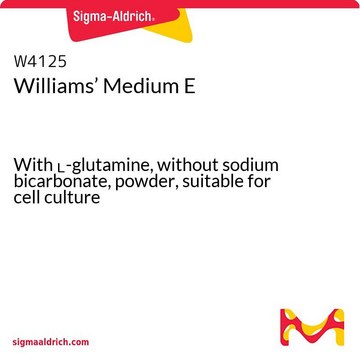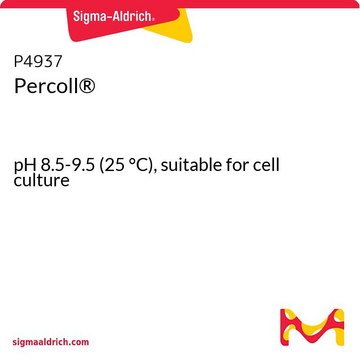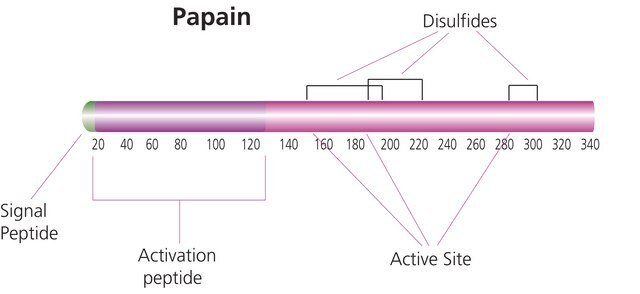W4128
Williams′ Medium E
With sodium bicarbonate, without ʟ-glutamine, liquid, sterile-filtered, suitable for cell culture
Synonym(s):
Williams’ E medium
Sign Into View Organizational & Contract Pricing
All Photos(1)
About This Item
UNSPSC Code:
12352207
NACRES:
NA.75
Recommended Products
Product Name
Williams′ Medium E, With sodium bicarbonate, without L-glutamine, liquid, sterile-filtered, suitable for cell culture
Quality Level
sterility
sterile-filtered
form
liquid
technique(s)
cell culture | mammalian: suitable
impurities
endotoxin, tested
components
L-glutamine: no
phenol red: 0.0107 g/L
glucose: 2.0 g/L (Dextro)
NaHCO3: 2.2 g/L
shipped in
ambient
storage temp.
2-8°C
General description
Williams′ Medium E has been shown to support the growth in long-term culture of adult liver epithelial cells.
Application
Williams′ Medium E has been used to culture primary human hepatocytes and to maintain hepatocellular carcinoma (JHH-6) cell lines.
Reconstitution
Supplement with 0.292 g/L L-glutamine.
also commonly purchased with this product
Product No.
Description
Pricing
Storage Class Code
12 - Non Combustible Liquids
WGK
WGK 1
Flash Point(F)
Not applicable
Flash Point(C)
Not applicable
Choose from one of the most recent versions:
Already Own This Product?
Find documentation for the products that you have recently purchased in the Document Library.
Customers Also Viewed
Florian Douam et al.
PLoS pathogens, 14(3), e1006908-e1006908 (2018-03-06)
Amino-acid coevolution can be referred to mutational compensatory patterns preserving the function of a protein. Viral envelope glycoproteins, which mediate entry of enveloped viruses into their host cells, are shaped by coevolution signals that confer to viruses the plasticity to
Hannah L Paish et al.
Hepatology (Baltimore, Md.), 70(4), 1377-1391 (2019-04-10)
Precision cut liver slices (PCLSs) retain the structure and cellular composition of the native liver and represent an improved system to study liver fibrosis compared to two-dimensional mono- or co-cultures. The aim of this study was to develop a bioreactor
Xiaowen Ma et al.
Liver research, 5(1), 16-20 (2021-08-06)
Mitophagy is a lysosomal degradation pathway that selectively removes damaged, aged and dysfunctional mitochondria. Recent advances in understanding mitophagy highlight its importance in various physiological and pathological conditions including liver diseases. However, reliable quantitative assays to monitor mitophagy in cultured
Wen-Xing Ding et al.
Methods in enzymology, 453, 397-416 (2009-02-17)
Mammalian autophagy has been well characterized in the liver and in hepatocytes. Autophagy plays important roles in the normal physiology of the liver and in the pathogenesis of several liver diseases. This chapter will discuss the commonly used methods for
Dongxin Zhao et al.
PloS one, 4(7), e6468-e6468 (2009-08-04)
The derivation of hepatic progenitor cells from human embryonic stem (hES) cells is of value both in the study of early human liver organogenesis and in the creation of an unlimited source of donor cells for hepatocyte transplantation therapy. Here
Our team of scientists has experience in all areas of research including Life Science, Material Science, Chemical Synthesis, Chromatography, Analytical and many others.
Contact Technical Service










